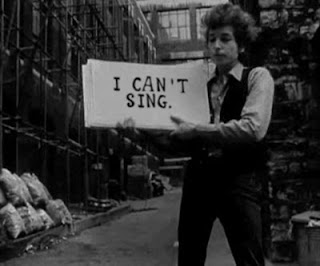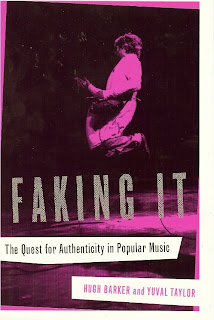"His milieu [Dylan’s] was that of the folk revival – an arena of native tradition and national metaphor, of self-discovery and self-invention…I was a place of the spirit, where authenticity in song and manner, in being, was the highest value – the value against which all forms of discourse, all attributes inherited or assumed, were measured" (Greil Marcus: 1998, 19).
 In the United States, the folk revival represented a movement that gave a voice to the younger generation during the palpable social and political transitions of the time. It was the rise of a countercultural movement which took on the musical folkloric traditions of the time when the US was facing economical turmoil. During the Great Depression of the 1930s, a working class folk singer by the name of Woody Guthrie wrote realms of simple yet prevailing songs that vividly detailed the American experience. From Guthrie came the idea that songs could carry hard-hitting messages of social and political protest. A decade after, Pete Seeger, the Harvard college journalist student dropout, also projected a leftist ideology with songs of protest with his banjo.
In the United States, the folk revival represented a movement that gave a voice to the younger generation during the palpable social and political transitions of the time. It was the rise of a countercultural movement which took on the musical folkloric traditions of the time when the US was facing economical turmoil. During the Great Depression of the 1930s, a working class folk singer by the name of Woody Guthrie wrote realms of simple yet prevailing songs that vividly detailed the American experience. From Guthrie came the idea that songs could carry hard-hitting messages of social and political protest. A decade after, Pete Seeger, the Harvard college journalist student dropout, also projected a leftist ideology with songs of protest with his banjo.The folk revival of the 1960s took on a similar philosophy to the ideals of Guthrie and Seeger. The moment that the “king and queen of folk” Joan Baez and Bob Dylan represented confirmed that music can challenge the political system and inspire the masses – all in the while of remaining as organic and truthful through the songs. Joan Baez has been a social commentator and a political activist till this day. In the PBS film, Joan Baez: How Sweet the Sound, she states that it was her duty to be a political activist as her social position was in the spotlight, and because the songs she sang about needed to parallel with her actions. Even though Dylan attended a few political demonstrations in his early stage of his career, I theorize he never wanted to position himself in the place of that political commentator.
Albeit his songs, especially for his lyrical content, which echoed anti-war and civil liberty sentiments, I feel it is safe to say that he did not want to carry the responsibility of being a representational leftist politician figure-like. I say this in the respect of directly voicing out the institutional discomforts without the song such like his comrade Baez did in every protest she attended. Dylan during the 1965 press conference interview in San Francisco was asked if his songs are “supposed to carry a political message,” of course Dylan’s answer was “Where did you hear something like that?” implying a “no” on my point of view. On a similar note, Baez states in the documentary No Direction Home by Martin Scorsese that she was always asked by protest attendees if Dylan would be joining her in political demonstrations. Joan would reply “You know he never comes to these things.” During his 1965 tour of England in the film Don’t Look Back he is interviewed by a Times Magazine journalist. Dylan says to the journalist:
"Are you going to see the concert tonight? Are you going to hear it? Okay, hear it and see it. It’s going to happen fast. You’re not going to get it all. You might even hear the wrong words. Afterword, I won’t be able to talk to you. I have nothing to say about these things I write. I just write them. I don’t write them for any reason. There is no great message. If you want to tell other people that go ahead and tell them. But I am not going to have to answer to it. And they’re just going to think: What is this Time Magazine telling us? But you couldn’t care less about that either. You don’t know the people that read you. I’ve had this hall [Albert Hall] filled up twice. I don’t need Time Magazine."
Furthermore, Dylan states that any classification that Time Magazine would imply on his persona would be wrong, and that they can not afford to print the “truth.” Dylan demonstrates honesty in his point of view as a musician while pointing out the falseness of corporate magazines such as Time. He points out the “pseudoness” and the sensationalism in the respect that the press may “hear the wrong words”.
On another angle, Dylan’s image with his acoustic guitar and harmonica, and the worlds of philosophy in his songs, was already in itself a symbol of resistance to the sociopolitical discomforts – with or without stating it directly in interviews or protests. From Dylan’s early albums such as Bob Dylan, The Times They Are A-Changin’ and so on Greil Marcus in Invisible Republic describes Dylan as “He was no longer merely a singer, or a songwriter, or even a poet, let alone simply a folk musician. In a signal way, he was the Folk, and also the Prophet.” He continues, “The sound of his hammered acoustic guitar and pealing harmonica became a kind of free-floating trademark, like the peace symbol, signifying determination and honesty, in a world of corruption and lies” (x). Furthermore, this demonstrates Dylan’s authenticity in the false industry of popular music. Though, during the height of his musical career during the mid 1960s, he was labeled of being a “sellout” during his transition from folk to folk-rock by going electric most notably in the Newport Folk Festival of 1965, were he was referred to “prostituting himself” with his leather “sellout jacket”. Although, looking at Dylan’s musical trajectory, the lyrical content remained similar with the exception of the amplification of volume and inclusion of rock instruments. I argue that he remained honest in the respect of representing his “true” self in the world of mass media and therefore authentic. It is “The advertising world [that] has proved the market appeal of celebrities” (Boorstin 58); the veil which hinders the folk hero’s authenticity.




